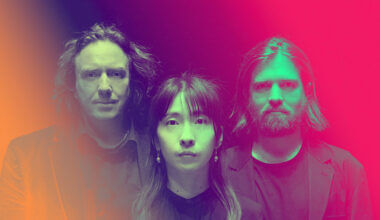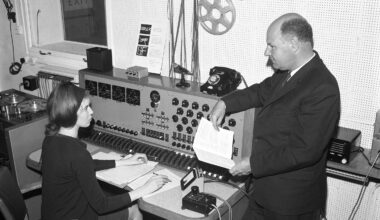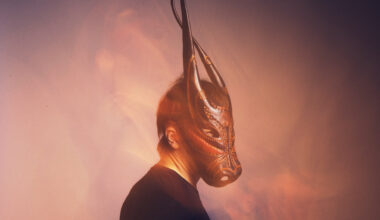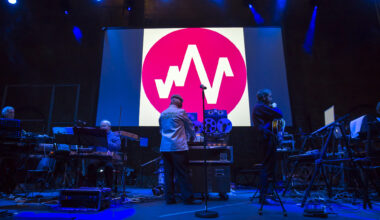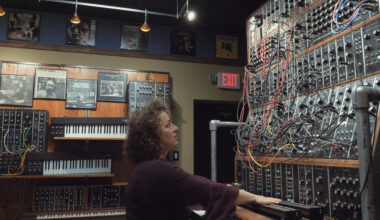“It was a fact of life as a little kid,” recalls Alexander Hacke, musician, producer, filmmaker and long-time Einstürzende Neubauten member, born and raised in Berlin and a major participant in the city’s post-punk, pre-rave scene in the 1980s. “I’d go out on the street and play, go around one more corner, and there would be a wall.”
West Berlin was an island city in post-war Germany; cut off from the rest of West Germany, walled in, a “city without a hinterland” as former Birthday Party and Bad Seeds man Mick Harvey puts it. In the late 1960s, it had been host to the Zodiak Free Arts Lab, a short-lived club co-founded by Conrad Schnitzler and Hans-Joachim Roedelius of Kluster, and a foundation stone of krautrock. A vibrant kosmische scene had evolved in the city, its chief proponents including dark ambient precursors Tangerine Dream and psychedelic space explorers Ash Ra Tempel.
Tangerine Dream, however, had taken to the skies and to international fame, floating free from the constraints of Berlin. Conversely, David Bowie had chosen to make the city his home, moving with a deeply shrewd dialectical consciousness from the fading rock west (LA and its washed up superstar deadbeats) to the rising east – the West Germany of Kraftwerk, Neu! and Cluster (rebranded after Schnitzler left the group). Having made his Berlin Trilogy of albums between 1977 and 1979 – ‘Low’, ‘Heroes’ and ‘Lodger’ – Bowie’s association with the city conferred on it, and West Germany in general, a cool it had not previously possessed in the eyes of the British, a Teutonic allure reflected in band name choices like Bauhaus and Spandau Ballet.
By the early 1980s, a new scene was developing across West Germany, with Berlin as a significant centre, which absorbed and interpreted punk in a city still divided and affected by the post-war hangover. Unlike krautrock, which was pacific, spacious, instrumental, implicit in its re-establishment of an avant-garde music, German in origin and departing from the orthodox cultural “Marshall Plan” of Anglo-American blues-based music, the West German music of the 80s was brutal, explicit, all concrete and twisted metal and shouted vocals, shaped by the physical form of the city of Berlin in particular. This was evidenced in the deconstruction/reconstruction of Einstürzende Neubauten and also in outsiders/insiders like DAF, whose track ‘Kebabträume’ was a sardonic reflection on life in the “Mauerstadt” (walled city), in which all citizens were in a sense as much “exiles” as the Turkish “guest worker” population.
Doyens of the Berlin post-punk scene included Mania D, Malaria!, Liaisons Dangereuses, Die Haut, Sprung Aus Den Wolken and, of course, Neubauten, who Alexander Hacke joined in 1980. He was just 15 at the time.
“I knew from very early on that I wanted to be a musician,” he says. “I had discovered the Ramones when I was 11 or 12, but also Suicide as well. Punk pretty soon became musically obsolete for me, it was just rock ‘n’ roll played a little faster, more aggressively. Groups like Suicide, using electronics, were more interesting. I’d skip school and hang out at the first punk independent store we had in West Berlin, in Schöneberg. I’d spend my afternoons there and I discovered all this new music. Eventually I met Neubauten’s Blixa Bargeld.
“I was very ‘patriotic’ about Berlin. It was the place of the weirdos. Berliners were known to be arrogant and aloof. You get to be proud of that when you’re young. I was not anti-America, but I was aware of the significance of the place that I was born in.”
Although only a teenager, Hacke found himself at the leading edge of West Berlin’s fast developing counterculture. His first girlfriend was Christiane Felscherinow, whose young life as a Berliner, drawn first to disco and then to drugs, was the subject of the 1981 movie ‘Christiane F’, directed by Uli Edel and featuring David Bowie.
“I met Bowie,” says Hacke. “But for me, as a radical young musician, I must admit he was not all that relevant. What he did was too mainstream for me. Iggy Pop was a different story. Also, my upbringing gave me a liberal understanding of gay culture – David Bowie hung out at these bars – and they turned mainstream because of him. That was a good thing, I suppose, it raised awareness of that lifestyle. But I was not a kid living in a repressed conservative town in West Germany. I knew this whole bohemian scene.”
Mick Harvey relocated to West Berlin in 1982. The Birthday Party, originally from Melbourne in Australia, decamped to the city from London, having failed miserably to settle in the UK. Berlin seemed the logical choice.
“We already knew the Malaria! girls, for instance, and we had loads of other friends in the city,” says Harvey. “We just thought, ‘Let’s move there’. Europe was very suspicious of this English new wave scene. Even in Germany, it only began in the early 1980s. It took a few years to filter through that it wasn’t a fashionable flash in the pan. It was a while before people worldwide realised it was about getting back to being elemental and being dangerous.
“The scene in Berlin was more like being in Melbourne for us in the late 70s. You’d go out to clubs and bars and the people were a big mixture of writers, filmmakers and painters, as well as musicians. We missed that in London, which felt very compartmentalised. It was hard to break into scenes, to get past the walls of self-importance built around them. Throw in the electronic aspect in Berlin, the German love of technology, and it becomes very interesting. People soaking up all those different influences, wanting to make something of their own, wanting to make something original… It was right in front of you.”
The impact of The Birthday Party, avant-gothic and fronted by a seemingly alien Nick Cave, who nonetheless felt like a mutant specimen of Weimar cabaret decadence, was immediate and substantial on the Berlin scene.
“The main thing was, they understood us, and we were all friends,” continues Harvey. “We wanted to be there and part of their local scene. That was very empowering. A lot of ex-pats moved to Berlin from other countries and we treated Berlin like a stateless city.”
Simon Bonney, frontman of fellow Australians Crime & The City Solution, a band that would take on all music genres, from country rock to electronics, followed in the footsteps of The Birthday Party shortly afterwards. Bonney was similarly disaffected with London.
“Berlin was a lot more welcoming,” he says. “Whatever the nightlife or social life that London had to offer, I didn’t find a way into it. Whereas Berlin was ready-made. It was unique. Historically, it was a city that people from West Germany were loath to go to. There was a government-sponsored scheme to persuade bureaucrats and professional people to live there, with financial compensation. At the same time, the authorities seemed to be content to let this counterculture exist in districts like Kreuzberg and Schöneberg.”
For Simon Bonney, it wasn’t just the counterculture of Berlin that was alluring, it was also the physical evidence of its historical role in the shaping of the 20th century – the ruins of the city, the visible marks of Berlin’s fall to the Russians in 1945.
“Seeing walls with bullet holes was fascinating,” he notes. “There was also a sense of impermanence, which is one of the reasons it attracted artists from all over the world.”
So international was the city, Bonney picked up virtually no German while he was there.
“None at all… I’m completely monolinguistic,” he confesses. “I’m not proud of that, I’m just useless with languages, but that was part of the appeal for me. I loved walking down the street not having a single clue what anyone was saying.”
Did he have any preconceptions challenged?
“The main preconception I had was about the East. Being a bit of a lefty, but too young to have understood what Czechoslovakia and Hungary really meant, I romanticised the East. Well, that was expunged the first time I set foot in East Germany. It was a bleak, totalitarian place, which would have crushed any free-thinking lefty. Or sent them to a gulag. That was a shock.”
Still bearing the weight of its history, both political and cultural, which stretched back 100 years, Berlin’s aura was palpable, and it was coupled with the reality of its environment and climate.
“There has always been a certain Berlin aesthetic, an appreciation of morbidity, a Berlin romanticism,” explains Alexander Hacke. “It gets very dark and cold in the winter. I had a friend in the 1990s, an artist from New Mexico. She lived here for a while, but finally it made her physically ill that she couldn’t see the sky!”
“The atmosphere was very heavy and it was all pervasive,” recalls Mick Harvey. “It had a novelty aspect for me, but the Germans would get this feeling of claustrophobia if they spent too much time in Berlin. They needed to get out to West Germany, out of the walled city. Defeated, destroyed, divided… Germans were very depressed, still even in the 1980s actually. A lot of the people I knew felt this. It was a hard cross to bear.
“The way the city functioned was unlike any other place. It was being kept alive artificially by funding and incentive schemes to get people to live there. But that gave a lot of fuel to people who thrived on that kind of oddity, who enjoyed that it was a deconstruction of a city. A lot of artists aren’t interested in things running smoothly.”
Overcast, isolated, depressed and dysfunctional, there were nonetheless significant advantages to life in Berlin. Most of the groups and denizens of the music scene hung out in the bars and clubs of Kreuzberg and Schöneberg, hip areas within a small, confined city that had their own, more lax rules.
“In West Germany, the bars would close early, but Berlin was non-stop,” says Hacke. “You could hang out at the same place for days. In West Berlin, there was also no draft for military service. So young West Germans who didn’t want to go into the army would move to Berlin and get themselves registered there.
“West Berlin was such a secluded place, such a small community, that if you did it well, you could make a real impact on the place. If you had the right look, the right story to tell, you could make an impact. And it was so easy to survive here. You could work in a bar, do a little job twice a week, and that would be fine to pay your rent.”
“In Berlin, it was considered normal to be in lots of different bands and be involved in very different projects,” says Simon Bonney. “That idea was new to me. In Australia, you were just in a band and that was the band you were in. Cross-pollination was a key part of Berlin, as well as working in different artistic forms – music, film, art.”
And so it was that Crime & The City Solution’s fluid line-up during the 1980s included Hacke, Harvey and also Chrislo Haas of proto-techno Berlin outfit Liaisons Dangereuses. Furthermore, as an Australian, Bonney identified with the West German quest for post-war cultural identity and the failure on the part of the culturally dominant British to take them seriously.
“Up until 1971, we had Australian prime ministers who would proudly boast about being British to their bootstraps. There then followed an awakening of Australian identity, but not a caricature like Barry McKenzie, the Barry Humphries creation. The punk rock scene in Melbourne wasn’t a carbon copy of what was being produced elsewhere. It reflected growing up in Australia at the time.”
“We were perceived in Britain as ‘colonials’,” adds Harvey. “It came as a surprise to the British that a band like The Birthday Party could come from Australia. Their ideas about Australia were still bound up with cans of Fosters…”
Hacke is convinced that drugs stronger than Fosters were a marker of Berlin’s shifting cultural identity, though.
“The Bowie era, that late glam rock era, that was when Christiane was a young teenager. That was a very strong heroin phase for West Berlin. In the early 80s, Berlin was about uppers – amphetamines and cocaine. And then the Australians came, The Birthday Party came, and heroin came back!”
In Théo Lessour’s ‘Berlin Sampler’, a cultural history of the city published in 2009, Lessour speaks of bands preserving their sense of avant-gothic cool through rivalry, by facing each other off with hard stares and dropping disparaging remarks. Mick Harvey, however, remembers none of this.
“I think we were probably outside that or maybe oblivious to it. We were friends with Malaria!, Neubauten, Sprung Aus Den Wolken, Die Haut… We were friends with everyone, despite all the drugs and the crazy drinking that was going on.”
That sense of community – “A very small, very overseeable community”, as Hacke describes it – was evident in the concert scenes of ‘Wings Of Desire’, Wim Wenders’ 1987 movie. Harvey and Bonney both appeared in the film, as did Blixa Bargeld, Nick Cave, Rowland S Howard and others.
“Wenders was a huge influence on me,” declares Bonney. “The way he used music to tell a story resonated with me, someone who was trying to write music that got away from the verse-chorus, verse-chorus format. Berlin supported and inspired that kind of songwriting. I mean, Neubauten are like no other band on Earth. And they just expanded, they just got rid of all the limitations that I might have felt about what you can or cannot do as a musician.”
Wenders wanted the musicians to be in ‘Wings Of Desire’ because he regarded their artistic endeavours as a vital energy in the make-up of 80s Berlin. It’s something other filmmakers might have overlooked. Harvey was initially concerned that their presence might be token, but was impressed by Wenders’ openness to their input.
“Wim doesn’t say a lot. He lets other people say their bit and lets other ideas come in. He’s a great music fan and has always been very generous about the things I’ve done.”
“The extras in those concert scenes, I know every single person in those audiences!” says Hacke. “It was very easy to round them up. Wim’s film portrays the atmosphere of the city really well.”
Brilliant and enduring as Wenders’ cinematic poem to 80s Berlin is, it conveys a sense of the city as locked for the long-term future in a state of hermetic melancholy, with the Wall as a permanent fixture, a reminder of the island city’s boundaries and a defining factor of its character. A little more two years later, however, the Wall would be breached and this particular phase of history declared at an end.
“It happened so quickly,” says Bonney. “We assumed the East German government was pretty stable, so it came as a shock. It’s as well that Wim made his film when he did, because he couldn’t have done it three years later.”
“No one had any inkling,” notes Harvey. “Even in December 1989, when the Berlin Wall was breached. Even then it was still two countries. Even on New Years’ Eve, you still had to get a visa to cross from West to East and you’d be fined if you weren’t back in time. I remember reading Der Spiegel, trying to predict what would happen about reunification. They were saying it would be 25 years away. The big turning point was the following January, when the East Germans discovered how corrupt their leaders were and how they all had Swiss bank accounts. That day, two million copies of ‘The Communist Manifesto’ were thrown into the doorways of the local Communist Party HQs. If that hadn’t happened, the reunification would have taken much longer.”
Hacke recalls the uncertainty and the mixed feelings that he experienced at the time.
“I was sitting at home with my son, who was one month old, and all these calls came in from people saying, ‘The Wall’s down’,” he remembers. “Personally, that frightened me. I didn’t have much contact with the average person on the street anyway, I was living in a secluded scene of freaks, and to think that now there would be double the amount of normal people out there… Yeah, that did frighten me. I stayed at home for quite a while. Many of my friends immediately wanted to go and explore East Berlin, but not me.”
Harvey felt much the same.
Another massive change in Berlin at that point was the advent of acid house and techno, the latter anticipated by Liaisons Dangereuses in 1981 with ‘Los Niños Del Parque’, a record acknowledged as hugely influential by many of the Detroit pioneers.
“Before techno, Berlin was prone to the cult of personality,” says Hacke, “David Bowie and The Birthday Party and so on. But with the techno scene, people didn’t gather to watch guys on a stage. There was a different philosophy. Different drugs too.”
One of the prime movers of the Berlin rave scene was Danielle de Picciotto, who has been married to Alexander Hacke since 2006.
“Danielle and her boyfriend at the time started the Love Parade festival in 1989,” explains Hacke. “It soon developed into what we all know, but then it was just a little group of people who travelled to London to go to acid house parties and brought some of the acid records back to Berlin, where they threw parties to play this new music. There was so much real estate in Berlin back then, so many huge places where you could stage illegal parties.”
Today, Berlin is arguably still the global capital of techno. But despite retaining much of its low-rent liberality, atmosphere and cachet, it has also become built-up, bought up, gentrified, corporatised, a city of “yuppies, hipsters, stag nights and pencil-necks,” as Hacke puts it.
“It’s strange to think that West Berlin is a city that doesn’t exist anymore,” says Hacke, casting back one last time to that faraway decade from another century. “I was born and raised in a city and I still spend my time in a city that doesn’t exist anymore.”


